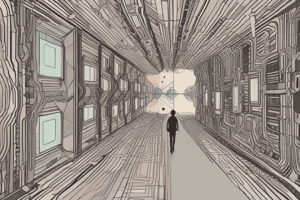Podcast
Questions and Answers
What characterizes associative visual agnosia?
What characterizes associative visual agnosia?
Which disorder is characterized by difficulties in navigating familiar environments?
Which disorder is characterized by difficulties in navigating familiar environments?
Achromatopsia is primarily associated with damage to which brain area?
Achromatopsia is primarily associated with damage to which brain area?
What is a prominent feature of simultanagnosia?
What is a prominent feature of simultanagnosia?
Signup and view all the answers
Prosopagnosia specifically impairs the recognition of which type of visual information?
Prosopagnosia specifically impairs the recognition of which type of visual information?
Signup and view all the answers
Which of the following best describes the visual processing pathway involved in achromatopsia?
Which of the following best describes the visual processing pathway involved in achromatopsia?
Signup and view all the answers
Which of the following conditions might coexist with prosopagnosia?
Which of the following conditions might coexist with prosopagnosia?
Signup and view all the answers
What characterizes associative visual agnosia?
What characterizes associative visual agnosia?
Signup and view all the answers
Which subtype of visual agnosia involves difficulty processing visual input as a whole?
Which subtype of visual agnosia involves difficulty processing visual input as a whole?
Signup and view all the answers
What is a defining feature of topographical agnosia?
What is a defining feature of topographical agnosia?
Signup and view all the answers
Achromatopsia is characterized by what inability?
Achromatopsia is characterized by what inability?
Signup and view all the answers
Prosopagnosia primarily affects an individual's ability to do what?
Prosopagnosia primarily affects an individual's ability to do what?
Signup and view all the answers
What remains intact in individuals with associative visual agnosia?
What remains intact in individuals with associative visual agnosia?
Signup and view all the answers
In which type of visual agnosia can individuals name objects based on non-visual modalities?
In which type of visual agnosia can individuals name objects based on non-visual modalities?
Signup and view all the answers
What type of damage is associated with associative visual agnosia?
What type of damage is associated with associative visual agnosia?
Signup and view all the answers
Individuals with simultanagnosia may have difficulty with what visual task?
Individuals with simultanagnosia may have difficulty with what visual task?
Signup and view all the answers
What is a common outcome for those with achromatopsia?
What is a common outcome for those with achromatopsia?
Signup and view all the answers
What is the primary characteristic of prosopagnosia?
What is the primary characteristic of prosopagnosia?
Signup and view all the answers
Which subtype of visual agnosia is characterized by an inability to navigate the environment?
Which subtype of visual agnosia is characterized by an inability to navigate the environment?
Signup and view all the answers
What distinguishes achromatopsia from other visual agnosias?
What distinguishes achromatopsia from other visual agnosias?
Signup and view all the answers
What type of agnosia involves a failure to attend to stimuli on the side opposite a brain lesion?
What type of agnosia involves a failure to attend to stimuli on the side opposite a brain lesion?
Signup and view all the answers
Which of the following is a common outcome in patients experiencing hemispatial neglect?
Which of the following is a common outcome in patients experiencing hemispatial neglect?
Signup and view all the answers
What type of agnosia is associated with an inability to recognize objects due to brain injury but retains normal face recognition?
What type of agnosia is associated with an inability to recognize objects due to brain injury but retains normal face recognition?
Signup and view all the answers
Which subtype of visual agnosia would not be characterized by neurological impairment?
Which subtype of visual agnosia would not be characterized by neurological impairment?
Signup and view all the answers
What behavorial pattern is observed in patients during the acute stages of hemispatial neglect?
What behavorial pattern is observed in patients during the acute stages of hemispatial neglect?
Signup and view all the answers
Which of the following is a testing method for assessing visual processing and agnosia?
Which of the following is a testing method for assessing visual processing and agnosia?
Signup and view all the answers
In what way might a patient with finger agnosia present symptoms?
In what way might a patient with finger agnosia present symptoms?
Signup and view all the answers
Study Notes
Visuospatial Disorders
- Visuospatial disorders are neurological conditions affecting visual perception and spatial reasoning.
- This topic is covered in the PSYU3344 Neuropsychology course at Macquarie University.
Tutorial Outline
- Visual Attention and Visual Processing
- Agnosia
- Hemispatial Neglect
- Constructional Apraxia
Part 1: Visual Attention & Visual Processing
- Attention supports conscious perception.
- Attention is capacity-limited.
- Attention is selective in nature.
- Attention involves fronto-parietal networks.
- Bottom-up processing is directly influenced by environmental stimuli and salience (involuntary).
- Involves the temporo-parietal junction and ventral frontal cortex (ventral attention network).
- Top-down processing is influenced by sensory input and experiences/expectations (voluntary).
- Involves the inferior and superior parietal sulcus, and frontal eye fields (dorsal attention network).
- Bottom-up and top-down processes interact in visual attention.
Visual Processing
- Damage to the earliest visual brain areas causes blindness.
- Damage to areas further along in the visual pathway affects specific features, like color or motion.
- Further damage results in object recognition deficits (visual agnosia).
- Visual information processing happens hierarchically.
- Early processing extracts elementary features (lines, angles, edges, color, motion).
- Ventral (what) and dorsal (where) pathways process complex visual information (object form, spatial representation).
- Visual processing involves a sequence of stages: local features, shape representation, and object representation.
Part 2: Agnosia
- Agnosia is the inability to process sensory information, affecting a single sensory modality.
- It's about recognizing objects/persons/sounds/shapes/smells, but the specific sense isn't faulty. No significant memory loss is present either.
- There are categories of visual agnosia (apperceptive and associative) and subtypes (simultanagnosia, prosopagnosia, achromatopsia, topographical agnosia, finger agnosia, agnostic alexia, akinetopsia).
Apperceptive Visual Agnosia
- Difficulty assembling pieces/features into objects (common objects).
- Represents a failure in perception.
- Not very common
- Intact: acuity, brightness discrimination, color vision, recognition for lines, colors, or angles.
- Impaired: Object naming, object matching, shape identification, or object copying.
Associative Visual Agnosia
- Can perceive whole objects but cannot name them, losing the link between visual input and meaning.
- Perception occurs, but recognition is impaired. More common than apperceptive agnosia.
- Intact: Acuity, brightness discrimination, color vision, recognition for lines, colors or angles, shape matching, or object copying.
- Impaired: Object naming based on visual input. Improved with verbal descriptions, drawings from memory, or context.
Subtypes of Visual Agnosia
- Simultanagnosia: Difficulty processing visual input as a whole (difficulty processing elements in a scene instead of the whole scene).
- Prosopagnosia: Difficulty recognizing faces (sometimes called face blindness).
- Different types of acquired prosopagnosia linked to different brain damage/illnesses. (acquired vs. congenital)
- Possible genetic link and a prevalence rate of 2-3%.
- Achomatopia: Inability to distinguish different colors.
- Topographical agnosia: Inability to navigate environments
- Finger agnosia: Inability to name/move/or touch specific fingers.
- Agnostic alexia: Inability to recognize words visually but can usually hear words.
- Akinetopsia: Motion blindness.
Testing for Visual Processing & Agnosia
- Various tests assess object naming, categorization, drawings, unusual views, or overlapping line drawings, other modalities or facial features.
- Specific batteries or tests like VOSP, BORB, Famous Faces tests.
Agnosia Case Studies
- Real-world examples demonstrated in YouTube videos. Examples from studies on agnosia and dyslexia, and normal face recognition.
Part 3: Hemispatial Neglect
- Characterized by a failure to attend, respond, or orient to a side of space opposite the brain lesion. It's not related to sensory loss.
- May extend to all sensory modalities for affected patients.
- Patients often don't know they have a deficit (anosognosia).
- Usually linked with right posterior parietal lesions, but also possible for right frontal, basal ganglia or thalamus lesions.
- Often transient, lasting a few weeks.
Acute Stages of Hemispatial Neglect
- Patients focus only on the non-neglecting side (e.g., eating one side of a plate).
- Visual field tests: placing a hand at one side might cause inability to fixate on center.
- Known as "compulsive orientation" to one side (the non-neglecting side).
- Affected patients may have difficulty remembering details on the neglected side. Common complaints are related to daily tasks like eating or dressing.
Later Stages of Hemispatial Neglect
- Extinction to Double Simultaneous Stimulation: Patient might only notice one object when two appear simultaneously, one on each side of spatial field.
- Different tests assess extinction to simultaneous stimuli.
Testing for Hemispatial Neglect
- Line bisection, star cancellation, bell test, and copying tasks help assess spatial awareness.
- Some assessment examples include drawing from memory tests.
Hemispatial Neglect vs. Visual Field Sensory Loss
- Hemispatial neglect: patient doesn't realize the deficit
- Does not compensate for deficit, and attentional not sensory.
- Visual field sensory loss: patient is aware of the deficit
- Compensates for the deficit.
Part 4: Constructional Apraxia
- Impairment in organizing or combining elements.
- Difficulty arranging elements in spatial relationships.
- Trouble perceiving how multiple parts make a whole.
- Tests like Copying, Clock Drawing and Block Designs are used for assessment.
Studying That Suits You
Use AI to generate personalized quizzes and flashcards to suit your learning preferences.
Related Documents
Description
This quiz covers visuospatial disorders, focusing on their impact on visual perception and spatial reasoning. Explore key concepts such as visual attention, agnosia, hemispatial neglect, and constructional apraxia as part of the PSYU3344 Neuropsychology course at Macquarie University.





